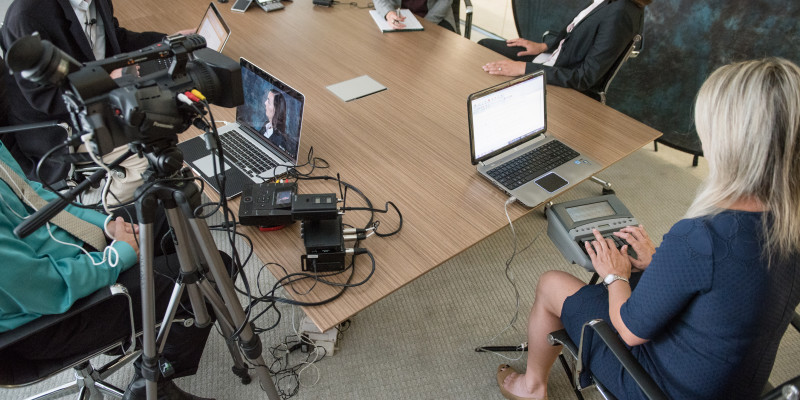Why Legal Videography Is Essential for Accurate Court Recordings
The duty of legal videography in court room settings can not be overemphasized, as it serves as an essential device for protecting the stability of court documents. The effects of integrating lawful videography into basic court methods elevate essential concerns concerning its more comprehensive impact on the legal system.
Relevance of Visual Proof
In the realm of legal proceedings, the relevance of aesthetic proof can not be overemphasized. Visual proof functions as a powerful device in developing truths, proving testimonies, and boosting the total clarity of a situation. This sort of proof, which includes photos, video clips, and representations, can give a tangible context that verbal summaries frequently do not have, thereby using courts and courts a more clear understanding of the situations surrounding a situation.
Furthermore, visual evidence aids in the retention of information. Human cognition is naturally aesthetic, and individuals are more probable to keep in mind and understand info provided in a visual format. In the courtroom, this can be crucial, as engaging aesthetic proof can persuade viewpoints and strengthen the narrative presented by legal representatives.
Additionally, using aesthetic proof can lessen misconceptions and obscurities that frequently occur from verbal exchanges. By offering a direct representation of events, visual evidence helps to eliminate subjective interpretations and cultivates an extra unbiased assessment of the truths. Subsequently, the assimilation of visual proof right into legal procedures not only reinforces the honesty of the judicial process however likewise enhances the possibility of achieving a simply result.
Capturing Non-Verbal Signs
Utilizing sophisticated videography techniques can considerably boost the capture of non-verbal hints throughout legal process. Non-verbal communication, consisting of faces, body movement, and eye contact, plays a crucial function in conveying emotions and purposes that may not be clearly mentioned in verbal testament. legal videography. Legal videography uses high-definition cameras and critical angles to make sure that these subtle signs are tape-recorded with clearness and precision
The ability to examine non-verbal behavior can supply important context to declarations made during court sessions. A witness's hesitation or self-confidence can be analyzed via their posture or gestures, potentially influencing the jury's understanding of integrity. Moreover, making use of close-up shots can help concentrate on a speaker's expressions, permitting a more nuanced understanding of the testimony.
Additionally, incorporating multiple video camera angles can create an extensive view of communications, highlighting characteristics in between celebrations included. This multifaceted method not only boosts the precision of the court document however also aids in maintaining the honesty of the judicial procedure - legal videography. Inevitably, capturing non-verbal cues through lawful videography fosters a richer, much more full depiction of courtroom procedures

Enhancing Statement Reliability
The integrity of statement can be substantially reinforced through the usage of premium legal videography. Video clip recordings function as an objective tool that catches not just the spoken words of official site witnesses but likewise the subtleties of their delivery, consisting of tone, pacing, and emotional expressiveness. This multifaceted documents offers a clearer understanding of the witness's reputation and intents, which can be critical in lawful procedures.
Furthermore, lawful videography reduces the possibility for misconceptions that might arise from composed records alone. When jurors can observe a witness's behavior and body movement together with their statement, they are much better equipped to evaluate the credibility and reliability of the evidence offered. This visual context can strengthen the testimonial story, making it much more engaging and reputable.
Furthermore, the presence of a video clip recording can hinder potential variances in testament. Witnesses may be a lot more mindful in their statements when they understand they are being taped, bring about more precise and genuine accounts. In general, high-grade legal videography enhances the stability of statement, making certain that the court has access to a complete and honest depiction of the facts as communicated by the witnesses.
Sustaining Appeals and Reviews
Lawful videography plays an important duty in sustaining allures and reviews by providing a comprehensive visual document of court room procedures. This visual documentation captures not just the talked words about his of witnesses and attorneys but also the subtleties of body movement, intonation, and court dynamics. Such components can be crucial in recognizing the context of statements and disagreements presented.
In the appellate procedure, where the emphasis is on mistakes of regulation and step-by-step fairness, a video document can act as an important tool for appellate courts. It makes it possible for courts to examine the original trial context, making certain that choices are based on a complete understanding of the process. The capacity to visually assess the demeanor of witnesses or the communications between parties can reveal understandings that written records might ignore.

Additionally, legal videography can aid in clearing up obscurities in testaments or procedural judgments, thereby enhancing the basis for an allure. By providing a reliable, unbiased account of what transpired in court, legal videography not just supports the stability of the lawful process however also encourages all parties included to make enlightened decisions regarding their instances.
Improving Court Room Procedures
Enhancing courtroom efficiency, legal videography enhances procedures by providing instant accessibility to aesthetic documents of proceedings. This modern technology permits judges, attorneys, and courts to revisit important testament and proof, ensuring that all events have a clear understanding of the situation. By capturing the subtleties of spoken and non-verbal interaction, videography enhances the document, making it easier to grasp the context and weight of testimonies.

Additionally, video recordings can facilitate remote engagement in hearings, enabling for better flexibility in scheduling and involvement, which is useful link especially useful in complicated cases including several stakeholders.
Final Thought
Finally, legal videography plays a vital function in ensuring accurate court recordings by giving crucial visual evidence that records both verbal and non-verbal communication. This method enhances the integrity of testimonies, supports appellate evaluations, and enhances court processes. By cultivating a thorough understanding of court dynamics, legal videography inevitably adds to extra fair judicial outcomes, reinforcing the integrity of the lawful system and facilitating informed decision-making.